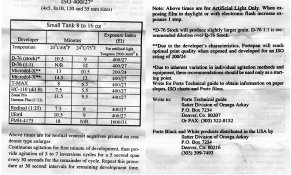braxus
Member
I have a few rolls of the 400 in 35mm. Its dated March 2002. First off should I rate it at 200 ISO or even lower? Secondly if I develop this myself in Xtol straight mix, can you recommend a developing time for this? Or should I wait until I get some HC 110 developer first? If I use that, what dilution and time would you recommend for that? I dont know the history of how the film was stored most of its life, as I got it a couple years ago off Ebay. I have 2 more rolls of this film too. So this will be a test roll.
The MDC site says 12 minutes for Xtol straight, and 9 minutes for Dilution B in HC 110. This is at 400 speed however. In HC110 its stated to be 7 1/2 minutes for 200 speed for HC110. Im not sure the stock time of 12 minutes for Xtol straight is correct, as D76 is only 9 minutes.
The MDC site says 12 minutes for Xtol straight, and 9 minutes for Dilution B in HC 110. This is at 400 speed however. In HC110 its stated to be 7 1/2 minutes for 200 speed for HC110. Im not sure the stock time of 12 minutes for Xtol straight is correct, as D76 is only 9 minutes.
Last edited:






